I have two tables (A and B), the table A contains the data of reports:

and table B, showing the exclusion data of these reports:

I would like to do a JOIN having as a resul the 'Exclude_reason' only for the report with inventoryreport_id = 7 only. The column inventoryreport_id (table B) comes from column id (table A)
I tried different types of join but nothing gives me the result I am looking for.
As result of RIGHT Join, I got this data, but this is not what I am looking for:

What I would like to have is the last 4 rows of table B.